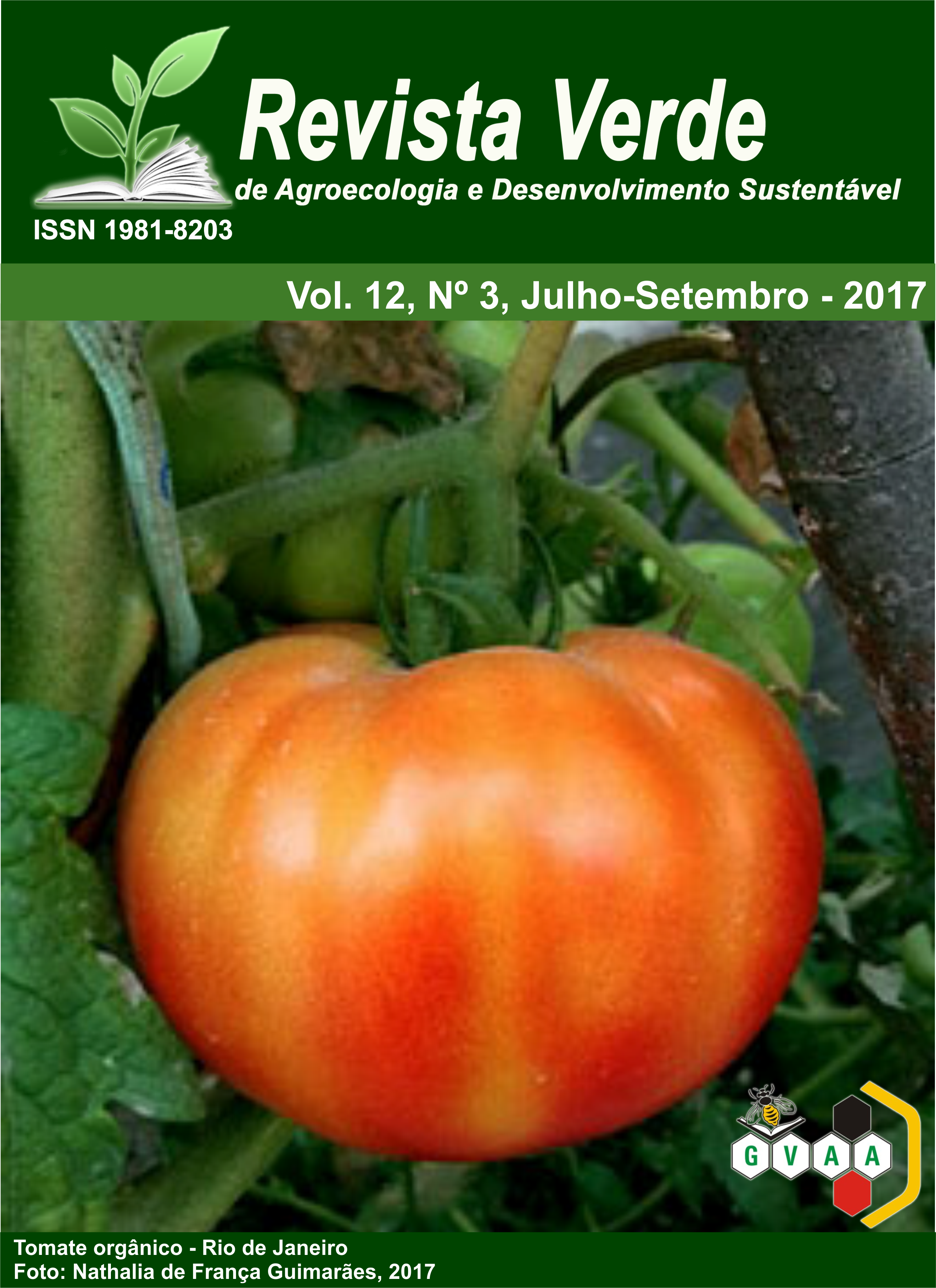Production and quality of fertirrgated cherry tomatoes with pisciculture wastewater
DOI:
https://doi.org/10.18378/rvads.v12i3.4775Keywords:
Effluent, Lycopersicum esculentum Mill., Probiotic.Abstract
The aim of this work was to evaluate the production and the quality of fertirrigated cherry tomatoes with pisciculture wastewater with and without probiotics. The experiment was conducted in pots, under ambient conditions protected by 50% sombrite. The experimental design was a completely randomized design with four treatments and four replicates, the experimental unit consisting of thirty-two plants. Four water slides were tested: water; water from fish farms without the use of probiotics; water with probiotic and probiotic pisciculture wastewater. Probiotic addition was performed every 48 hours, with 0,5 g of probiotic containing at least 5x109 billion colony forming units per viable gram for every 8 L of water, each plant receiving 1 L of water manually in the morning. The soil used in the experiment to fill the vessels was classified as a NEOSOLO QUARTZARENIC dystrophic sandy texture caatinga stage, mixed with organic compound. The results showed that there was no difference between treatments for yield, number of fruits, fruit weight and pH. The treatment of water with probiotic was the one that presented lower acidity and better relation SST / ATT. The reuse of fish water with and without addition of the probiotic for fertirrigation of the cherry tomato crop did not interfere in the fruit production.Downloads
References
ALVARENGA, M. A. R. Tomate: produção em campo, casa de vegetação e hidroponia. 2.ed. Lavras: Editora Universitária de Lavras, 2013.
ALVES, W. W. A.; AZEVEDO, C. A. V.; NETO, J. D.; LIMA, V. L. A. Área foliar do algodoeiro irrigado com água residuária adubado com nitrogênio e fósforo. Revista Verde de Agroecologia e Desenvolvimento Sustentável, Mossoró, v. 4, n. 1, p. 41-42, 2009.
ANESE, M.; FALCONE, P.; FOGLIANO, V.; NICOLE, M. C.; MASSINI, R. Effect of equivalent thermal treatments on the color and the antioxidant activity of tomato purees. Journal of Food Science, v.67, n.9, p.3442-3446, 2002.
ASSOCIATION OF OFFICIAL ANALYTICAL CHEMISTRY. Official Methods of Analysis of the Association of Official Analytical Chemistry. 15 th. 33 E. Washington, 1995. 2v.
TOLEDO, N.; FERRER, J.; BORQUEZ, R. Drying and storage stability of a probiotic strain incorporated into a fish feed formulation. Drying technology, v.28, n. 4, p.508-516, 2010.
BRASIL. Ministério da Saúde. Agência Nacional de Vigilância Sanitária. Métodos físico-químicos para análise de alimentos, p. 1018, 2005.
CAMARGO, L. K. P.; RESENDE, J. T. V.; GALVÃO, A. G.; BAIER, J. E.; FARIA, M. V.; CAMARGO, C. K. Caracterização química de frutos de morangueiro cultivados em vasos sob sistemas de manejo orgânico e convencional. Semina: Ciências Agrárias, v. 30, p. 993 - 998, 2009.
CARVALHO, L. A.; NETO, J. T.; ARRUDA, M. C.; JACOMINO, A. P.; MELO, P. C. T. Caracterização físico-química de híbridos de tomate de crescimento indeterminado em função do espaçamento e número de ramos por planta. Revista Brasileira Agrociência, Pelotas, v. 11, n. 3, p. 295-298, 2005.
CASTRO, R. S.; AZEVEDO, C. M. S. B.; BEZERRA NETO, F. Increasing cherry tomato yield using fish effluent as irrigation water in Northeast Brazil. Scientia Horticulturae, v.110, p.44 - 50, 2006.
CHITARRA M. I. F; CHITARRA A. B. 2005. Pós-colheita de frutos e hortaliças: fisiologia e manuseio. Lavras: UFLA, 320p.
GUILHERME, D. O. Produção e qualidade de frutos de tomateiro cereja cultivados em diferentes espaçamentos em sistema orgânico. 2007. 63 f. (Tese Mestrado) –Universidade Federal de Minas Gerais, Montes Claros.
GUIMARÃES, M. A. Influência da poda apical e da posição do cacho do tomateiro no crescimento da planta e na qualidade dos frutos. Viçosa, MG: UFV, 2004. 93p. Dissertação (Mestrado em Fitotecnia) – Universidade Federal de Viçosa, Viçosa.
INSTITUTO ADOLFO LUTZ. Normas analíticas, métodos químicos e físicos para análise de alimentos. São Paulo, 1985.
KADER, A. A. Postharvest technology of horticultural crops. Davis: University of California. p.535, 2002.
MEDEIROS, D. C.; AZEVEDO, C. M. S. B.; MARQUES, L. F.; SOUSA, R. A; OLIVEIRA, C. J. Qualidade de mudas de tomate em função do substrato e irrigação com efluente de piscicultura. Revista Brasileira de Agroecologia. 8(2): 170-175, 2013.
MOHAPATRA, S.; CHAKRABORTY, T.; KUMAR, V.; DEBOECK, G.; MOHANTA, K. N. Aquaculture and stress management: a review of probiotic intervention. Journal of Animal Physiology Animal Nutrition, v. 97, n. 3, p. 405 - 430, 2013.
MONTEIRO, C. S.; BALBI, M. E.; MIGUEL, O. G.; PENTEADO, P. T. P. S.; HARACEMIV, S. M. C. Qualidade nutricional e antioxidante do tomate “tipo italiano”. Alimentos e Nutrição, Araraquara v.19, n.1, p. 25-31, janeiro/março, 2008.
NASCIMENTO, A. R.; JÚNIOR, M. S. S.; CALIARI, M.; FERNANDES, P. M.; RODRIGUES, J. P. M.; CARVALHO, W. T. Qualidade de tomates de mesa cultivados em sistema orgânico e convencional no estado de Goiás. Horticultura Brasileira, v. 31, n. 4, p. 628-635, 2013.
NASSUR, R. C. M. R. Qualidade pós-colheita de tomates tipo italiano produzidos em sistema orgânico. Lavras: UFLA, 2009. 127 f. Dissertação (Mestrado em Ciência dos ALimentos) – Universidade Federal de Lavras.
RODRIGUES, M. B.; DORNELLES, A. L. C.; OLIVEIRA, S. A.; MORAES, M. R. J.; LISBOA, F. J.; SILVA, D. A. G.; PEREIRA, M. B. Características físico-químicas de frutos de 25 cultivares de tomateiro tipo cereja. Horticultura brasileira, n. 2, 26: 2008.
SOUZA, J. A. R.; MOREIRA, D. A.; FERREIRA, P. A.; MATOS, A. T. Avaliação de frutos de tomate de mesa produzidos com efluente do tratamento primário da água residuária da suinocultura. Engenharia na Agricultura, v. 18, n. 3, p. 198-207, 2009.











